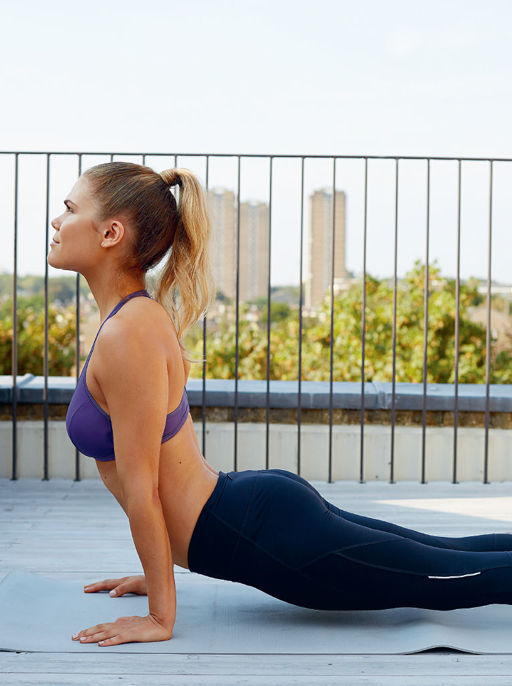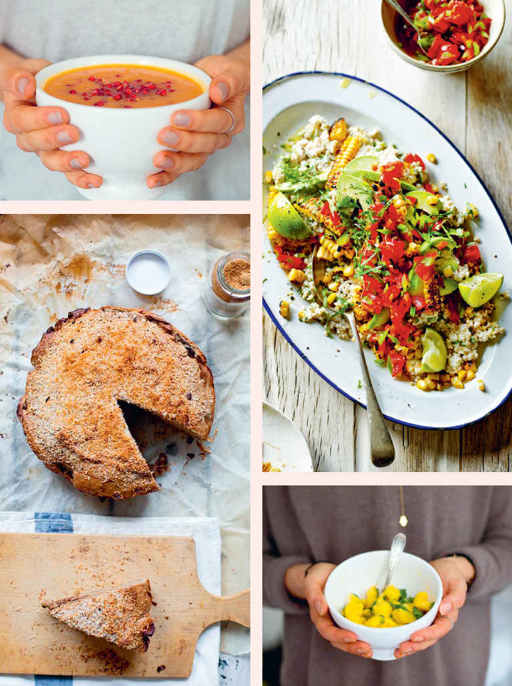Get the Glow (6 page)
Authors: Madeleine Shaw

• The gelatin found in bone broth is a hydrophilic colloid, helping to support proper digestion.
• It contains easily absorbable calcium, magnesium, phosphorus, silicon, sulphur and trace minerals.
• It reduces inflammation in the body.
• The gelatin also promotes healthy hair and nail growth.
For those who suffer with terrible digestion, I recommend drinking one to two cups of bone broth a day.
how to make bone broth
• 500g grass-fed beef bones (or other animal bones)
• 1 white onion, roughly chopped
• 2 bay leaves
• 2 tsp sea salt
• 4 tbsp cider vinegar
Wash your bones in warm water. Place them in a large stock pot, or your biggest pot. Cover the tops of the bones with water. Put the onion in the water, along with the rest of the ingredients. Bring to the boil, then reduce to a very low heat and simmer for 4–6 hours. Strain the broth through a sieve and put it in containers. The broth is freezable, so divide it up and keep some for a later date.
Use in soups, to sauté veggies or to drink before meals.
5. more ways to beat the bloat
You now have all the foundations to aid your digestion and heal your gut. Here are some more quick tips, if you need a little extra boost:
• Take amino acid L-glutamine, aloe vera, slippery elm and magnesium citrate.
• Drink a cup of camomile, liquorice root or peppermint tea; these soothe and relax the belly.
• Give your tummy a massage in a clockwise circular motion to start moving everything around.
• Take belly breaths – breathe deeply into your belly; inhale for three counts and exhale for four counts. This calms the nervous system and gets blood pumping around the digestive system.
• Add a teaspoon of apple cider vinegar to your water before you eat; this will get your digestion going.
• Get some sunshine: vitamin D helps regulate your immune system, crowds out pathogens and regulates the microbiomes.
Q&A
Q: How much protein should I eat?
A: Aim for a fist-size of protein in all of your meals. Mix up the sources to keep it interesting, and always eat foods you love – for example, don’t force-feed yourself fish if you don’t like it. This is all about enjoyment, not punishment.
Q: Can you have too many eggs?
A: Yes, you can overdo any food. Our bodies love variety, so just stick to two eggs three times a week.
Q: Where can I find probiotics and fermented foods?
A: Your local health food store, a chemist, or online.
Q: If something is labelled as ‘gluten free’, does this mean it’s OK?
A: Not always. Many gluten-free products are pumped full of chemicals trying to replicate the gluten. Stick to breads made from rice, buckwheat, quinoa or millet flour. If you’re not gluten intolerant, rye or spelt are also great options. As a rule of thumb, look for bread with the fewest ingredients or make your own.


REST
and
DIGEST
week five

Stress not only affects your mind, but also your waistline, digestion and overall well-being. This week I will show you how to say goodbye to stress to enable the hottest, healthiest and happiest you.
mindful eating
It not just about what you eat but how you eat. Eating mindfully is a very important part of getting the glow. It allows you to savour every morsel of your food, meaning you will eat less, feel fuller, reduce bloating and digest food more quickly.
We live life fast: we eat on the go, standing up, in front of the computer, and hardly ever at the table. Most of us are overstressed, overtired and overworked, which often leads us to mindlessly shove bad food into our mouths and make poor lifestyle choices.
When we eat on the go we are in a state of ‘fight or flight’, meaning our blood is directed to our muscles instead of going to the digestive system where it is needed. We should sit down mindfully with our meals and switch to a state of rest and digest. This is the sweet spot.
Mindfulness isn’t just about how you eat, but is about being conscious in everything we do. It helps us to get out of our heads and into our hearts. Reduced mind chatter certainly makes for happier and healthier living.
how to eat mindfully
•
Eat at a table:
Not standing up.
•
Turn off any distractions
: No TV, computer, phone or work. This helps you feel fuller and more connected to your food as you concentrate on what is on your plate, not on the screen.
•
Chew your food:
Your body works hard to draw all the nutrients out of your food, so help yourself by chewing 10 times before you swallow. This will make you eat less,
feel full quicker, and vanquish that post-dinner bulge.
•
Wait 20 minutes to get seconds
: It takes a while to feel full, so you might not actually need that extra portion.
•
Take breaths between mouthfuls:
Don’t wolf it down, enjoy it! Taking your time allows you to appreciate your food and enjoy its taste and texture.
meditation
If you are like me and seem to be always in your head, thinking, worrying and daydreaming, meditation may be the key to your happiness. There has been lots of exciting research into the notion that the gut is our second brain. With 100,000 neurotransmitters lining the length of the gut, it really is quite sensitive. The brain and gut are connected by the vagus nerve, which travels from the base of the brain to the gut. If your digestive system is out of whack, pain signals are sent up to the brain. When you put life’s stresses on top of this . . . all hell breaks loose. Therefore calming the mind helps calm the gut.
For me mediation was the final factor that helped heal my digestive problems and stop stress taking over my life. Meditation is about training the mind to be conscious. It is a great tool to help you become present. Most of the time we live worrying about the future or reliving the past. Meditation allows you to be present and enjoy the moment, as well as these other benefits:
• It helps reduce stress
• It relaxes the body and mind
• It makes you feel calmer and happier.
how does meditation work?
There are numerous ways to meditate. Some people do yoga, t’ai chi, dancing or painting to get out of their heads and into their bodies. The most well-known form, though, is seated meditation.
To do this, find a quiet place where you feel comfortable, and turn off all distractions. Sit on a chair, or on the floor with your legs crossed, and close your eyes.
Inhale for three counts, then slowly exhale for four counts. Breathe into your belly not into your chest – this helps calm your nervous system. Feel your belly rise and fall. Repeat this ten times, keeping your eyes closed and your mind focused on your breathing. Try not to let your mind wander. If it does, just come back to counting your breaths. When you’re finished, slowly bring yourself back into the present and see how much better you feel.
Try meditating every day for a week, and at the end of the seven days look back to see how much calmer you feel. Start by mediating for a minute, then slowly add on another until you are able to sit calmly for around 20 minutes. Make this part of your routine, and don’t let things get in the way. You can always make time to meditate: do it between meetings, on the train or before bed. There is always space in the day to be still.
work it out
When I lived in Sydney I was so inspired by the attitude people had to exercise. It was a way of life, a social engagement. There was no laziness about it; people would get up at 5am to catch the first wave.
I wasn’t into exercise growing up, and I’ve never liked the gym, but daily movement has not only built up my booty but has given me boundless energy and helped me to manage stress.
I find it’s best to exercise in the morning – that way it’s done, and no last-minute work crisis or social engagement will get in the way. Pop your gym bag by the door and commit to a class with a friend – buddying up will help you turn up! Put it in your diary just as you would an appointment you can’t miss; treating it with importance will make sure it gets done.
If you can’t afford a gym subscription, commit to a walk, go for a quick jog or even do a free aerobics class on YouTube! Don’t make excuses . . . you can do it.
replenish your reserves
Quite a lot of us push ourselves in the gym. It is therefore super-important that we replenish our reserves afterwards, so we can get up and do it again tomorrow. What you should eat post-workout depends on what exercise you did.
•
High-intensity cardio workouts:
Stick to healthy fats and proteins. Make my Strong and Lean Smoothie (see
here
), Scrambled Eggs with Pesto and Avocado (see
here
) or Smoked Salmon and Fattoush Salad with Avocado Mash (see
here
).
•
Lifting weights:
It’s better to have more carbs post-workout, but stick to things like my Sweet Potato Dip (see
here
), Green Queen Quinoa Dish (see
here
) or one of my Post-Workout Balls (see
here
).
Try not to exercise on a full stomach, as it takes your body a few hours to digest food. I like to have a smoothie or juice before a session, as smoothies and juices can be absorbed quickly by the body. Coffee is also a great pre-workout drink
as it is packed with antioxidants. Don’t abuse it, though, and only use it if you’re training in the morning.
Other books
Swimming Across the Hudson by Joshua Henkin
My Dearest Friend by Nancy Thayer
The Secret at the Polk Street School by Blanche Sims, Blanche Sims
Cool With Her by Wright, Kenny
HIM—A Stepbrother Romance: With BONUS NOVELLA: PERSONAL by Stephanie Brother
Kill the Dead by Richard Kadrey
Foretellers (The Ydron Saga Book 3) by Bolton, Raymond
Sex Me Up by Xander, Tianna, Leigh, Bonnie Rose
Untitled by Unknown Author
Drop Dead Beauty by Wendy Roberts
